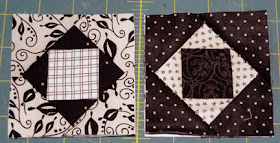This project uses 3" foundations, and is approx. 14" x 14" finished size.
Step 1. Trim foundation COPY a scant 1/8" beyond outer solid (final trim) line.
Step 2. Next, use a straight edge (bookmark, postcard, small flat ruler) to make a guide edge to crease the foundation on all inner SOLID lines. Note how the foundation is being folded so that printed side of foundations are on the inside.
Step 3. Measure patch #1 (center square) size, outlined in red here. Cut designated fabric patch with 1/4" + 1/4" seam allowances added to that size, or 2" for this project block.
Step 4. Turn foundation so printed side is DOWN. Attach fabric patch backside to backside of foundation using fabric glue stick - just a dab will do. The fabric edges should extend beyond the area's creased lines approx. 1/4".
Here is patch #1 in position on the BACKSIDE of the foundation.
Step 5. Turn foundation over to be print side up. Fold at crease between patch #1 and patch #2. Use a rotary ruler and cutter to trim excess fabric patch away at selected seam allowance width. Repeat this for remaining 3 sides of square. For most projects, this would be the 1/4" previously referenced. Here, I am using the "Add-An-Eighth" ruler which has a raised lip 1/8" in from right edge. When I align it at the crease, that lip "catches" at fold to help me trim at exactly the right place. Eighth-inch allowances work well for miniatures or small scale blocks. Use the "Add-A-Quarter" ruler if you prefer the larger allowance.
Step 6. Analyse for information to pre-cut the triangle patches for the first row (#2-5). Here, one of those triangles is highlighted. With the 1/4" line of the ruler at triangle "square" edge, I can estimate that a 2" half-square triangle would be about right. Round slightly higher for security, such as 2 1/4", if desired. At right, two fabric squares are cut, then cut on the diagonal to produce the 4 patches needed to complete this round of one block.
Step 7. Fold over the diagram on the same line as step 5, for patch #2. (Here it is highlighted in red on front and back of the sample foundation.)
Step 9. Move to the sewing machine. Adjust the stitching length to about half the length of the usual straight stitch used in conventional piecing. You can see the stitch length in photo for Step 14. (For regular stitching on my Pfaff machine, I usually set the stitch length at 3+. For foundation piecing, I set it at 2.) Short stitching helps perforate the paper for easier removal later. Working with miniatures, it also makes the seam more secure for narrow-cut allowances.
Stitch, beginning 2-3 stitches before the diagrammed line begins (the line between what is already in place and what is being added). Stitch across the line, making the needle pierce the layers exactly ON the line. Stitch 2-3 stitches beyond the end of the line. Pull away from machine, clip threads, etc.
Step 11. Move to rotary mat. Fold back on stitching line. Use Add-A-Quarter ruler to trim away extending triangles tips.
Continue adding the first row of triangle patches #3-5 in the same manner, repeating steps 8, 10-11. This photo shows row 1 complete.
Step 15. Press patch back. Turn work over on cutting mat, re-fold diagram and trim tips as in step 11. Repeat positioning, stitching, pressing and trimming of tips for #7.
Step 18. Turn the foundation over; place on the cutting mat. Use a rotary ruler and cutter to trim the block to its finished size by trimming exactly on the outer solid line. Try to "split" the line as you cut for increased precision.
Here is the final block, trimmed to final size.
Step 19. Remove the paper. Begin at the highest number patch. Fold back on the seam line, then begin at one end to tear away the paper section at the stitching perforations. Continue to the next highest number. Flex the fabric to release it from where it was previously connected at stitching. Fold and tear away. Keep working in reverse number order until all paper is removed. (#1 patch affixed with glue may need slightly more effort to remove.) Once paper is removed, handle patches with care to avoid stretching any bias edges.

Nine Block Table Mat Project
For the project shown at the top of this blog, prepare 5 "dark" blocks (right) and 4 "light" blocks.
Lay out the 9 blocks as shown. Join into rows, then join rows. Press seams in opposing directions. Add borders and/or posts as desired.
For this layout, cut:
4 narrow borders 1" x 9 1/2"
4 post corners 1" x 1"
4 outer borders 2 1/2" x 10 1/2"
4 outer post corners 2 1/2" x 2 1/2"
binding of choice.
Layer, machine quilt, attach binding, and you're done.
Now, wasn't that fun!
Watch for other foundation piecing tutorials to continue
learning more advanced layouts and shapes placement techniques.






























































